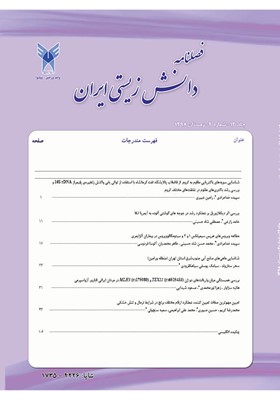تعیین مهمترین صفات تعیین کننده عملکرد ارقام مختلف برنج در شرایط نرمال و تنش خشکی
محورهای موضوعی : زیست شناسیمحمدرضا کریم 1 , حسین صبوری 2 , محمدعلی ابراهیمی 3 , سمیه سنچولی 4
1 - دانشجوی سابق کارشناسی ارشد بیوتکنولوژی کشاورزی
2 - دانشگاه گنبد کاووس
3 - استاد گروه بیوتکنولوژی دانشگاه پیام نور تهران
4 - دانشگاه گنبد کاووس
کلید واژه: تجزیه علیت, تنش خشکی, برنج, صفات مورفولوژیکی, تجزیه خوشهای,
چکیده مقاله :
بهمنظور ارزیابی اثر تنش خشکی بر عملکرد و تعدادی از صفات وابسته به آن، 14 ژنوتیپ برنج (شامل 5 رقم بومی و 9 رقم خارجی) در قالب طرح بلوک کامل تصادفی در سه تکرار در دو محیط بدون تنش (غرقاب) و تنش خشکی در مزرعه تحقیقاتی واقع در شهرستان علیآبادکتول (زیر نظر دانشگاه گنبدکاووس) مورد مطالعه قرارگرفت. آبیاری مزرعه آزمایشی در هر دو محیط غرقاب و تنش، تا مرحله پنجهدهی ارقام بهطور یکسان به صورت غرقاب انجامشد، سپس برای ایجاد تنش، آبیاری از 40 روز پس از نشاء (مرحله حداکثر پنجهزنی) به فاصله هر 25 روز تا پایان فصل زراعی انجام شد. نتایج تجزیه واریانس نشانداد که تفاوت معنیداری بین ژنوتیپها از نظر کلیه صفات مورد مطالعه در دو شرایط مطالعه وجود داشت. بیشترین میانگین عملکرد در شرایط نرمال و تنش متعلق به ژنوتیپهای lR83752-B-B-12-3 و سپیدرود بود. وزن خوشه (**85/0) در شرایط بدون تنش (غرقاب) و حجم ریشه (**98/0) در شرایط تنش خشکی، بالاترین همبستگی مثبت و معنی-داری را با عملکرد دانه داشتند. نتایج تجزیه علیت نشان داد که در شرایط بدون تنش، تعداد خوشه و در شرایط تنش خشکی، تعداد دانه پر خوشه دارای بالاترین اثر مستقیم و مثبت بر عملکرد دانه داشتند. در گروهبندی ارقام بر اساس تجزیه کلاستر با استفاده از روش ward، ارقام در شرایط نرمال و تنش در سه گروه قرار گرفتند. نتایج تجزیه کلاستر نشانداد که ارقامIR83752-B-B-12-3 ، Pegaso و سپیدرود که دارای حجم، وزن تر و وزن خشک ریشه بیشتری نسبت به ارقام دیگر بودند در گروه متحمل به خشکی قرار گرفتند.
In order to evaluate the effect of drought stress on yield and the other related traits, 14 rice genotypes (including five varieties of landrace and introduced varieties) in a randomized complete block design with three replications in two environments without stress (flooding) and drought stress in the field Research located in Aliabad (under the supervision of Gonbad Kavous University) was studied. Irrigation of experimental farm in both the flood and drought were flooded until maximum tillering stage. Irrigation was performed every 25 days until the end of the season from 40 days after maximum Tillerin). Analysis of variance showed significant differences among genotypes for all traits in both conditions. The average yield of the genotypes in the normal and stress conditions lR83752-BB-12-3 and was Sepedroud. Panicle weight (0.85**) under stress (flooding) and root volume (0.98**) in drought stress conditions, the highest positive correlation with grain yield were Significant. Path analysis results showed that different traits were involved in justifying grain yield under non-stress and drought stress conditions, so that in non-stress condition, number of panicle and in drought condition, number of filled grain per panicle had the highest direct and positive effect on grain yield. In grouping cultivars based on cluster analysis using ward method, cultivars were divided into three groups under normal conditions and stress. The results of cluster analysis showed that Pegaso, IR83752-B-B-12-3 and Sepidrood cultivars, which had more volume, fresh weight and root dry weight than other cultivars, were in the drought tolerant group.
_||_


